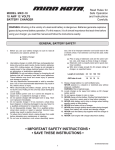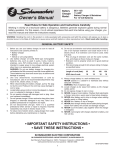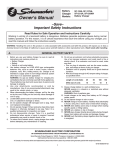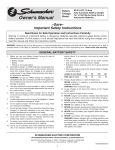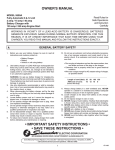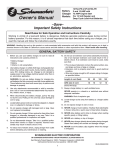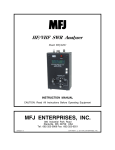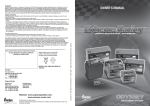Download Schumacher MKC-10 Operating instructions
Transcript
Read Rules for Safe Operation and Instructions Carefully MODEL MKC-10P 10 AMP 12 VOLTS BATTERY CHARGER WARNING: Working in the vicinity of a lead-acid battery is dangerous. Batteries generate explosive gases during normal battery operation. For this reason, it is of utmost importance that each time before using your charger, you read this manual and follow the instructions exactly. GENERAL BATTERY SAFETY 1. 10. Do not use an extension cord unless absolutely necessary. Use of an improper extension cord could result in fire or electric shock. If an extension cord must be used, make sure that: Before you use your battery charger, be sure to read all instructions and cautions printed on: • Battery Charger • Battery 2. • Pins on plug of extension cord are the same number, size, and shape as those of plug on charger. Use battery charger on LEAD ACID type rechargeable batteries only, such as used in autos, trucks, tractors, airplanes, vans, RV's, trolling motors, etc. Charger is not intended to supply power to low-voltage electrical system other than in an automotive or boat/marine application. • Extension cord is properly wired and in good electrical condition. • Wire size is large enough for AC ampere rating of charger, as specified below: WARNING: Do not use battery charger for charging drycell batteries that are commonly used with home appliances. These batteries may burst and cause injury to persons and damage to property. 3. 4. Use only attachments recommended or sold by manufacturer. Use of non-recommended attachments may result in fire, electric shock, or injury. Locate battery power cord so it cannot be stepped on, tripped over, or subjected to damage or stress. 6. Do not operate charger with damaged cord or plug. Have cord replaced immediately. 7. Do not operate charger if it has received a sharp blow, been dropped, or otherwise damaged in any way. Take it to a qualified professional for inspection and repair. 8. Do not disassemble charger. Take it to a qualified professional when service or repair is required. Incorrect reassembly may result in electric shock or fire. 9. 25 50 100 150 AWG size of cord: 18 18 16 14 11. Always charge battery in a well ventilated area. NEVER operate in a closed-in or restricted area without adequate ventilation. When disconnecting the battery charger, pull by the plug not by the cord. Pulling on the cord may cause damage to cord or plug. 5. Length of cord (feet): WARNING: Risk of explosive gas. 12. Locate charger as far away from battery as DC charger cables permit. 13. Do not expose charger to rain or snow. 14. NEVER charge a frozen battery. If battery fluid (electrolyte) is frozen, bring into a warm area to thaw before charging. 15. NEVER allow battery acid to drip on charger when reading specific gravity or filling battery. 16. NEVER set a battery on top of charger. 17. NEVER place charger directly above battery being charged. Gases from battery will corrode and damage charger. 18. NEVER touch the battery clips together when the charger is energized. To reduce risk of electric shock, unplug charger from outlet before attempting any maintenance or cleaning. 19. NEVER crank engine with charger attached to battery. • IMPORTANT SAFETY INSTRUCTIONS • • SAVE THESE INSTRUCTIONS • 00-99-000344/0503 1 PERSONAL PRECAUTIONS AND SAFETY 1. WARNING: Wear complete eye protection and clothing protection, when working with lead-acid batteries. 2. Make sure someone is within range of your voice or close enough to come to your aid when you work with or near a lead-acid battery. 3. Have plenty of fresh water and soap nearby for use if battery acid contacts skin, clothing, or eyes. If battery acid contacts skin or clothing, wash immediately with soap and water. 4. 5. 6. Take care not to drop a metal tool or other metal onto the battery. Metal may cause sparking or short circuit the battery or another electrical device. Sparking may cause an explosion. 7. Always operate battery charger in an open well ventilated area. 8. Battery chargers get hot during operation and must have proper ventilation. Air needs to flow around entire charger. 9. Do not set battery charger on flammable items like carpeting, upholstery, paper, cardboard etc. Charger may damage leather and melt plastic and rubber. Avoid touching your eyes while working with a battery. Acid particles (corrosion) may get into your eyes! If acid enters your eye, immediately flood eye with running cold water for at least 10 minutes. Get medical attention immediately. 10. NEVER smoke or allow a spark or flame in the vicinity of the battery or engine. Batteries generate explosive gases! Remove all personal metal items such as rings, bracelets, necklaces, and watches when working with a lead-acid battery. A lead-acid battery can produce a short-circuit current high enough to weld a ring (or the like) to metal, causing a severe burn. 11. WARNING: Handling the cord on this product or cords associated with accessories sold with this product, will expose you to lead, a chemical known to the State of California to cause cancer and birth defects or other reproductive harm. Wash hands after handling. PREPARING TO CHARGE 1. Make sure you have a 12 volt lead-acid battery. Check owner manual to make sure. 2. Clean battery terminals. Take care to keep corrosion from coming in contact with your eyes. 3. If required, add distilled water in each cell until battery acid reaches levels specified by battery manufacturer. This helps purge excessive gas from cells. Do not overfill. For a battery without cell caps, carefully follow manufacturer's recharging instructions. 4. Study all battery manufacturer's specific precautions, such as removing or not removing cell caps while charging, and recommended rates of charge. 5. Be sure area around battery is well ventilated while battery is being charged. Gas can be forcefully blown away by using a piece of cardboard or other non-metallic material as a fan. 6. A marine (boat) battery must be removed and charged on shore. To charge it on board requires equipment specially designed for marine use. BATTERY SIZE/RATING MARINE / OR DEEP CYCLE MCA AMP HR 220-350 350-600 600-935 24-40 40-70 70-104 CCA: COLD CRANKING AMPS MCA: MARINE CRANKING AMPS 2 3-5 5-9 9-13 RES. CAP.: RESERVE CAPACITY AMP HR: AMPERE HOUR BATTERY CHARGER CONTROLS FIGURE 3 - CHARGER CONTROLS MANUAL-AUTOMATIC SWITCH Charging may be either Manual or Automatic. NOTE: Some batteries, especially those with a built in state of charge indicator and have been deeply discharged, may require the use of the MANUAL position in order to obtain full charge. The AUTOMATIC position may be used to maintain the full charge state. MANUAL When the Manual position is selected the charger will continue to charge and will not shut off. You must keep a visual check on the ammeter or the green LED to determine when the battery is charged. When the ammeter reads around 5 Amps and the green LED is on the battery is charged. METER/LED INDICATOR The meter gives a reading of the AMP draw on the charger. When a fully discharged battery is connected to the charger, the meter will read the maximum output rating of the charger. The charge current will gradually taper down as the battery approaches full charge. As the charge current tapers, the meter needle will also move down. WARNING: In the Manual position, the charger will continue to charge even after the battery is fully charged. WARNING: Overcharging will damage the battery. AUTOMATIC CHARGING When the battery reaches the full charge state, charge current is turned off and the charger switches to the maintainer mode of operation. This action occurs when the ammeter tapers down to approximately 5 Amps. In this state the battery voltage is constantly being monitored. When the battery voltage drops to a predetermined value charge will turn on for a few seconds replacing the small amount of energy that was lost while the charge current was at 0 Amps. When full charged, the meter needle will suddenly drop to 0 and a green LED will turn on. The 0 is not printed on the meter scale, the LED is located in its place. As a visual aid, the meter scale has been divided into 2 zones, CHARGED and CHARGING. NOTE: As the battery approaches the full charge state the meter needle and LED will fluctuate back and forth between CHARGING and CHARGED. For the average size automotive battery, allow 5 to 10 minutes for the battery to stabilize. MANUAL VS AUTOMATIC CHARGING For your safety, in the AUTOMATIC position this charger will only turn on when properly connected to a 12 volt battery with a voltage over .7 volts. In the MANUAL position the charger will turn on for any condition. If a battery is so depleted of charge that it's voltage is less than .7 volts, switch to MANUAL until the ammeter begins to move up scale, than switch back to the desired AUTOMATIC position. NOTE: A buzz or hum is normal when the output cables have been disconnected and the AC power cord is still connected to an electrical source (i.e. wall outlet). These types of noises will also occur when the green light comes on indicating the battery is "Completely Charged". At this point, the charger has stopped charging the battery, but still hums or buzzes until the electrical power is shut off. READING METERS D C AMPS CHARGED 2 4 D C AMPS CHARGING 6 8 10 12 CHARGE COMPLETE FULLY DISCHARGED BATTERY Initial charge current to the battery is typically 10 Amps. CHARGED 2 4 D C AMPS CHARGING 6 8 10 12 CHARGED 2 4 CHARGING 6 8 10 12 CHARGE COMPLETE CHARGE COMPLETE APPROACHING FULL CHARGE Charge current to the battery is typically 6 Amps. FULLY CHARGED BATTERY Charge current to the battery is 0 Amps and the green LED is on. 3 CIRCUIT BREAKER NOTE: Clicking sound is normal. Wait until charger automatically resets itself. This battery charger is equipped with a self-resetting circuit breaker. This device protects the charger from temporary overloads. In the event of an overload, the circuit breaker will trip open and after a short cooling off period will reset automatically. This process is known as cycling and can be recognized by an audible clicking sound. CAUTION: Persistent clicking (more than 30 minutes) may indicate reverse connection or shorted battery cells. (See TROUBLESHOOTING) BATTERY TYPES Three basic types of lead-acid batteries can be given a charge with this charger: (1) Conventional and Low Maintenance, (2) Maintenance Free, (3) Deep Cycle / Marine. Conventional and Low Maintenance Batteries. These are the antimony/lead batteries. Conventional/Low Maintenance batteries require periodic addition of water to the acid solution (electrolyte). Additional water may be added by removing the filler caps located on the top of the battery. ing of electrolyte level and provides access to the battery for water additions, the battery is probably a Low Maintenance/ Conventional type. Maintenance Free Batteries. These are calcium/lead batteries and normally do not require water additions. Therefore, filler caps have been removed from the battery surface. These batteries will have a smooth or sealed appearance. IMPORTANT: When antimony is known to be one of the materials used in the battery's construction, that battery is a Low Maintenance/Conventional type. Deep Cycle Batteries. These heavy duty batteries are used in boats, construction equipment, sump pumps, etc. They are normally marked DEEP CYCLE on the outside of the case. CAUTION: Some Low Maintenance batteries have a relatively smooth top without any apparent battery filler caps. If, however, the battery manufacturer/distributor recommends periodic check- OPERATING INSTRUCTIONS: CHARGING BATTERY OUT OF THE VEHICLE battery when making final connection. Rock clip back and forth to make a good connection. When charging battery, take care to determine the battery type. To reduce risk of a spark near battery, follow these steps. FIGURE 7 shows the connection. WARNING: A spark near battery may cause battery explosion. WARNING: When removing battery from vehicle or boat, disconnect grounded pole first. When disconnecting, make sure the engine/motor and all accessories are off, so as not to cause an arc. (NOTE: BOAT BATTERIES MUST BE REMOVED AND CHARGED ON SHORE. (TO SAFELY CHARGE ON BOARD REQUIRES SPECIAL EQUIPMENT ESPECIALLY DESIGNED AND UL LISTED FOR MARINE USE. THIS CHARGER IS NOT WATER RESISTANT AND SHOULD NOT BE EXPOSED TO WET CONDITIONS.) Attach a 24-inch long (or longer) 6-gauge (AWG) insulated battery cable to NEGATIVE (NEG, N, -) battery post. 3. Connect POSITIVE (RED) charger clip to POSITIVE (POS, P, +) post battery. Rock clip back and forth to make good connection. 4. 6. Turn switch from off to on. 7. When battery is fully charged, unplug charger from AC power source. 8. When battery is fully charged and charger is unplugged, (1) remove clip from end of Negative end of cable, and (2) remove clip from Positive battery post, in that order. 9. Clean and store battery charger. NEGATIVE BATTERY CHARGER Check polarity of battery posts. Battery case will be marked by each post: POSITIVE (POS, P, +) and NEGATIVE (NEG, N, -). NOTE: The positive battery post usually has a larger diameter than the negative post. 2. Plug charger AC cord into 120 volt grounded outlet. POSITIVE WARNING: When reinstalling battery, attach the ground post first. 1. 5. BATTERY + POWER CORD 24", 6 GAUGE CABLE TO GROUNDED POWER OUTLET Position yourself and free end of 24 inch cable as far away from battery as possible. Then connect NEGATIVE (BLACK) charger clip to free end of cable. WARNING: Do not face FIGURE 7 CONNECT NEGATIVE BATTERY CLIP TO 24 INCH CABLE END 4 TROUBLESHOOTING The battery charger is designed to work automatically. However, If a problem does occur, check the following: PROBLEM POSSIBLE SOLUTION No meter reading. Charger is not plugged in. Plug in Connections are reversed. With charger unplugged, reverse clamps and reconnect (rock back and forth to bite in). Poor electrical connection. Clean clamps and battery poles and reconnect (rock back and forth to bite in). AC outlet is dead. Plug in a lamp or other appliance to check for voltage. Battery is defective (will not accept charge). Have battery checked. Battery recently used in vehicle and is fully charged. Battery does not need changing. (If battery is in vehicle, turning on headlights will lower battery voltage in a few seconds and charger should then turn on.) Charger will not turn on when properly connected to power. Battery has less than .7 volts, set to Manual and retry. Charger will not turn OFF. Battery has a problem and will not take a full charge. Have battery checked. (If in MANUAL, switch to AUTOMATIC). Meter needle pulses (fluctuates) every few seconds AFTER THREE HOURS without slowing down. Two or more batteries connected in parallel. Requires more time to charge: continue charging. Battery of 200 ampere hours or larger. Requires more time to charge: continue charging. Battery is connected to application that draws a small current (such as a vehicle's dome light). Requires more time to charge: continue charging. Battery is partially charged. Continue charging. Battery is defective (battery plates are crusted) and will not accept a full Have checked and replace battery. charge. AC power supply is low. Plug charger into another grounded AC outlet. Severely discharged battery (but otherwise good battery). Allow charging to continue until battery has recovered sufficiently to take a charge (Circuit breaker will continue to cycle and needle will swing side to side until battery has recovered). In MANUAL with battery connections reversed. Unplug charger and change to correct connections. Battery is defective (will not accept charge) Have battery checked. Charger is cycling after circuit breaking overload. Wait until charger automatically resets itself (DO NOT RETURN FOR SERVICE). Charging current is less than full output rating of charger. Meter needle moves to extreme right, remains a short time, then returns to zero, accompanied by a clicking sound. NOTE: This product is manufactured for Minn Kota by Schumacher Electric Corporation. If you have any questions regarding the operation of this charger please contact Schumacher Electric technical service at 1-800-621-5485, Ext. 322. 5 MAINTENANCE/CLEANING INSTRUCTIONS Very little maintenance is required for the battery charger. Follow common sense in wiping the charger clean and store in a clean, dry area. 1. 2. 3. After use, wipe all battery corrosion and other dirt or oil from clip, cord, and the charger case. Use a dry cloth. Coil charger cords to prevent damage. 4. Have any cracked or frayed cords replaced by a qualified professional. Store battery charger in a clean, dry area. LIMITED WARRANTY SCHUMACHER ELECTRIC CORPORATION, 801 BUSINESS CENTER DRIVE, MOUNT PROSPECT, ILLINOIS 60056-2179 MAKES THIS LIMITED WARRANTY TO THE ORIGINAL PURCHASER AT RETAIL OF THIS PRODUCT. THIS LIMITED WARRANTY IS NOT TRANSFERABLE. THIS IS THE ONLY EXPRESS LIMITED WARRANTY AND THE MANUFACTURER NEITHER ASSUMES NOR AUTHORIZES ANYONE TO ASSUME OR MAKE ANY OTHER OBLIGATION TOWARDS THE PRODUCT OTHER THAN THIS EXPRESS LIMITED WARRANTY. THE MANUFACTURER MAKES NO WARRANTY OF MERCHANTABILITY OR FITNESS FOR PURPOSE OF THIS PRODUCT AND EXPRESSLY EXCLUDES SUCH FROM THIS LIMITED WARRANTY. Schumacher Electric Corporation warrants this battery charger for one year from date of purchase at retail against defective material or workmanship. If such should occur, the unit will be repaired or replaced at the option of the manufacturer. It is the obligation of the purchaser to forward the unit together with proof of purchase, transportation and/or mailing charges prepaid to the manufacturer or its authorized representative. SOME STATES DO NOT ALLOW THE EXCLUSION OR LIMITATION OF INCIDENTAL OR CONSEQUENTIAL DAMAGES OR LENGTH OF IMPLIED WARRANTY SO THE ABOVE LIMITATIONS OR EXCLUSIONS MAY NOT APPLY TO YOU. This limited warranty is void if the product is misused, subjected to careless handling, or repaired by anyone other than the manufacturer or its authorized representative. THIS WARRANTY GIVES YOU SPECIFIC LEGAL RIGHTS AND YOU MAY ALSO HAVE OTHER RIGHTS WHICH VARY FROM STATE TO STATE. The manufacturer makes no warranty other than this limited warranty and expressly excludes any implied warranty including any warranty for consequential damages. 6 NOTES 7 • IMPORTANT SAFETY INSTRUCTIONS • • SAVE THESE INSTRUCTIONS • Minn Kota Battery Charger Manufactured by Schumacher Electric Corporation 1-800-621-5485 8








